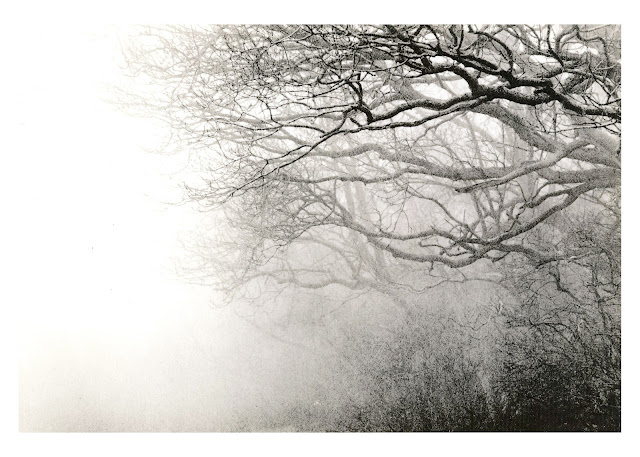Aversley Wood Lith: To the Unknown
Another set of Lith prints. My last session from this set of negatives I explored as far as I could. The toning did not turn up anything interesting. This next image I have passed up for conventional printing I think because it is off balance. There is a lot of white space on the left side. It does, however, have layers in the branches in the fog and I came to think that what is there is what is not there. That the point of the white space is to suggest what is not there, the unknown.
So, I started to print and develop it with lith developer. I measured the Ev at ISO 100 in the brushy area under the trees on the right. I set the aperture (f8) for 32 seconds at Ev of 3 which is my reference point. (Again I opened the aperture one stop to f5.6 to cut the exposure time to 16 seconds.) The bright empty area is a full stops less light on the paper so I knew some burning there would be needed.
I tried 2 stops of burn on the left at first, but this was too much so I settled on 1 stop of burn. I started with Oriental Seagull #3 paper. What I got was some tremendously detailed prints. Almost not like many lith prints but clearly exhibiting infectious development. They exhibit differences from each other depending on the snatch point and the progress of infectious development. I made 3 nice images on the Oriental Seagull paper.
 |
| f5.6 16 sec 16 sec burn (Scan001) |
 |
| f5.6 16 sec 16 sec burn (Scan002) |
 |
| f5.6 16 sec 16 sec burn (Scan003) |
The first and last of the three seem best.
Next, I resized the image for my Fohar Raster (5x7") paper. This odd Hungarian paper liths reasonably well but really shines in terms of toning. It has a lot more soul I think than the Oriental Seagull paper. I made two reasonable lith prints which by themselves do not reveal too much in terms of tone, but I expect to get some better results with toning.
 |
| f8 16 sec burn 16 sec (Scan004) |
 |
| f11 16 sec burn 16 sec (Scan006) |
In both of these I had more of the fogging on the borders and I bleached and refixed briefly to clear up much of this.
More Papers: Experimenting
Next, I wanted to try out different papers I had laying around to see if they were lithable.
I had a sheet of 8x10 Fotospeed lith I had forgotten about. (My earlier Fotospeed lith papers were taken from a partial bx of 16x20 paper I bought a number of years ago and I have perhaps 3 sheets left.) For this 8x10 I cut it in half to make a 5x8 sheet that I could print on without a new 5x7 setup.
 |
| Fotospeed Lith Paper (Scan007) |
The Fotospeed paper did not disappoint. It had the expected rich warm pink tones that I like about the paper.
I next moved to an old unopened pack of ORWO BN 113 8x10" paper. I had another pack of small ORWO paper that I had tried to lith before with no success and so I did not expect much from this pack. I was wrong though. The paper exhibited good infectious development. It has a slightly warm but mostly neutral tone to it, so it is not as exciting as Oriental Seagull or Fotospeed Lith paper.
 |
| ORWO BN 113 (Scan006) |


Comments